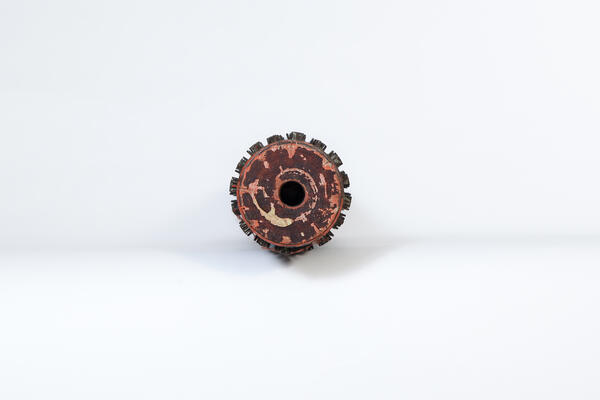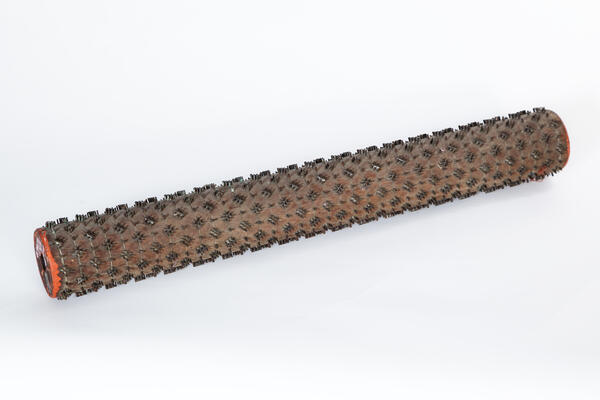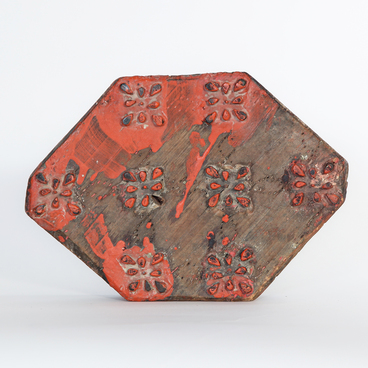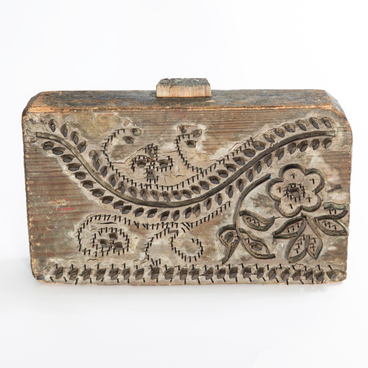The so-called manera, or a roller-shaped woodblock, was used to create a pattern on cloth. Special handles were inserted on the sides to hold it. On its working surface is a geometric pattern made of copper pegs and plates in a chessboard order. The manera was donated to the museum by its founder, the artist and ethnographer Pyotr Ivanovich Subbotin-Permyak, who collected 570 samples of woodblocks for textile printing from all over the Permyak region.
Subbotin-Permyak was the first to study the dyeing craft and technologies of decorating fabrics in the Kama region. He made sketches of the patterns, explored their origin and meaning, talked to artisans. He was interested in everything connected, as he said, “with the ornamentika in the Permyak region”. Pyotr Ivanovich taught at the Stroganov Art and Industry School in Moscow and organized art workshops for children. He was able to combine in his art the features typical of the Kama region with those of Impressionism and the Russian avant-garde.
It was Russian craftsmen who introduced woodblock printing to the artisans of the Permyak region. The craft had its heyday in the late 18th — early 20th century. Perm artisans added to it some local folk features, a unique outlook, and a special attitude toward the symbols in nature and legends. In his workshop every dyer had several hundreds of woodblocks of different shapes: round, triangular, rectangular, square and roller-shaped ones. They consisted of one, two or three boards, fastened tightly with wooden nails. The blocks made in the early 20th century were fastened with metal nails. For durability the blocks were additionally fastened with a wedge: such fastening guaranteed that the blocks would not warp because of moisture. The pattern on the woodblocks was made of wooden and metal pins of 2–3 mm high, less often of plates, which were used to create a line in the pattern.
The centers of the woodblock printing craft in the Permyak region were located in large villages of Kudymkar, Peshnigort, Beloevo, Verkh-Inva, Karpovo, Oshib, Timino, Yurla, and Kosa. Woodblocks were most often made of birch, less often of linden and spruce. In his covering notes to the albums Pyotr Ivanovich Subbotin-Permyak wrote that “the dyeing industry is of exceptional importance for Permyaks. There are printers in a number of villages in the Permyak region”. Some of the woodblocks have preserved the marks with the names of the craftsmen.
Subbotin-Permyak was the first to study the dyeing craft and technologies of decorating fabrics in the Kama region. He made sketches of the patterns, explored their origin and meaning, talked to artisans. He was interested in everything connected, as he said, “with the ornamentika in the Permyak region”. Pyotr Ivanovich taught at the Stroganov Art and Industry School in Moscow and organized art workshops for children. He was able to combine in his art the features typical of the Kama region with those of Impressionism and the Russian avant-garde.
It was Russian craftsmen who introduced woodblock printing to the artisans of the Permyak region. The craft had its heyday in the late 18th — early 20th century. Perm artisans added to it some local folk features, a unique outlook, and a special attitude toward the symbols in nature and legends. In his workshop every dyer had several hundreds of woodblocks of different shapes: round, triangular, rectangular, square and roller-shaped ones. They consisted of one, two or three boards, fastened tightly with wooden nails. The blocks made in the early 20th century were fastened with metal nails. For durability the blocks were additionally fastened with a wedge: such fastening guaranteed that the blocks would not warp because of moisture. The pattern on the woodblocks was made of wooden and metal pins of 2–3 mm high, less often of plates, which were used to create a line in the pattern.
The centers of the woodblock printing craft in the Permyak region were located in large villages of Kudymkar, Peshnigort, Beloevo, Verkh-Inva, Karpovo, Oshib, Timino, Yurla, and Kosa. Woodblocks were most often made of birch, less often of linden and spruce. In his covering notes to the albums Pyotr Ivanovich Subbotin-Permyak wrote that “the dyeing industry is of exceptional importance for Permyaks. There are printers in a number of villages in the Permyak region”. Some of the woodblocks have preserved the marks with the names of the craftsmen.




